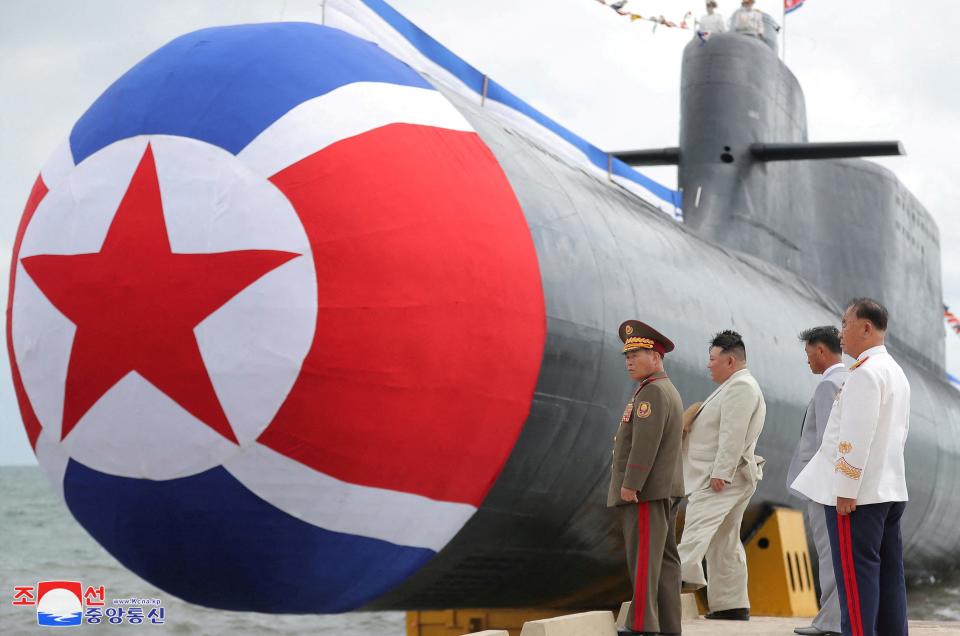North Korea's new missile sub looks kind of shoddy, but the US and its allies can't afford to ignore it
North Korea recently unveiled a heavily reworked Cold War-era submarine with new missile capabilities.
Pictures show the new modifications. The sub looks a little shoddy, and it may not be fully operational.
But even if it's based on the inferior Romeo subs, the new boat is still a threat and a bargaining chip for North Korea.
North Korea recently unveiled a new "tactical nuclear attack submarine" that appears to actually be a reworked Cold War-era conventionally-powered submarine with new missile capabilities. And while the vessel's design seems rather shoddy, the US and its allies can't really afford to ignore the potential threat it poses or its role as a bargaining chip.
On Friday, North Korea's state media announced the launch of its new "Korean-style" ballistic missile submarine.
The vessel, Submarine No. 841, also known as Hero Kim Kun Ok, was originally unveiled Wednesday, with North Korean leader Kim Jong Un saying it would become the key "underwater offensive means of the naval force" of the nation, adding to the nation's submarine fleet.
Photos from the launch ceremony at Sinpho South Shipyard showed what analysts say is a modified Romeo-class submarine, a Cold War-era vessel. It's possibly the same Romeo sub that was being reworked when Kim visited the shipyard in July 2019. The sub appears to have undergone significant reworks and design changes — the most notable being a major extension of a missile compartment, which is now longer and can carry more weapons.
It's a new platform for North Korea to threaten its enemies, especially considering that the submarine appears to be able to carry short- and long-range submarine-launched ballistic missiles (SLBMs) such as the Pukguksong-1 and Pukguksong-3 and potentially submarine-launched cruise missiles (SLCMs) like the Hwasal-2 land-attack cruise missile, all of which have a range covering all of South Korea, Japan, and US bases in those countries if launched from North Korean waters.
"This is really just a way of having another mobile missile launcher that can, in this case, go underwater and be hard to find," Bryan Clark, a former US Navy officer and defense expert at the Hudson Institute, told Insider. "Which is not that much different than what the North Koreans already do with their mobile missile launchers that hide in caves."

Romeo-class submarines were originally build by the Soviet Union in the late 1950s and early 1960s. The capability was shared, and China later developed its own variant. North Korea acquired some of them from China but also built some of its own.
The ones North Korea obtained predated some efforts to silence the noisy diesel-electric submarines, so the boats and their later derivatives are considered quite loud, at least as far as subs are concerned.
Tom Shugart, a defense analyst and former submariner wrote on X, formerly Twitter, that the North Korean sub "looks cool" and "makes for an impressive ceremony," but he also said he would bet his "next pension check that it's loud."
The noise makes it easier to track, and also because the sub is conventionally powered, as opposed to nuclear powered, it'll have to resurface every few days to recharge and could, at that point, be easily detected — not ideal for stealthier, long-distance missions far from home. For security, it will have to stay close to North Korean shores, where South Korea and Japan, as well as the US, can keep a closer eye on its whereabouts.
Despite the North Korean announcement, it's not entirely clear if the sub is fully operational yet. South Korean military officials said North Korea is likely exaggerating the capabilities of the vessel, and it's unclear if it'll immediately be able to effectively host SLBMs and SLCMs, nuclear or otherwise.
The ability to carry those kinds of weapons, though, was the main modification to the Romeo sub, which now features a somewhat crude-looking missile tower — including multiple vertical launch tubes — jutting out of its hull.
"It is kind of shoddy, like many of the early versions of ballistic missile submarines that any national has put out," Clark said. In most cases like this, missile tubes are essentially strapped or bolted on to the vessel, with the main goal really being to see if the initial sub can go underwater, be somewhat difficult to find, and pose a threat to an enemy. More sophisticated designs tend to come later.

The modified Romeo sub sports a somewhat clunky look and time will tell if it's able to make the most of its many modifications, but the sub does give North Korea a new way to threaten the US and its allies.
"It's really a messaging tool for North Korea," Clark told Insider. "It gives them a way to threaten attacks with less warning against Japan and South Korea in particular," and it "might be a good tool in their negotiations with them," giving them more power alongside land-based missiles and artillery to pressure or coerce.
It also shows that North Korea is actively prioritizing new nuclear capabilities for its Navy. With likely 19 other Romeo-class subs in its stockpile, it's possible that Kim could focus on converting at least some, if not many, of those in a similar fashion to this vessel. Although work would go slowly, it'll give North Korea another way to add to its nuclear strike power.
If it were to be used in combat, though, the Romeo sub would likely only get one shot, and it would likely need to be a preemptive attack. After that shot, it's unlikely the vessel could escape fast enough or remain undetected, making it vulnerable to a counterattack.
In other words, it's "a tool that helps with North Korea's strategy," Clark said, but at the moment, "it's not really something that's going to provide a very strong operational benefit."
Read the original article on Business Insider

 Yahoo News
Yahoo News 
